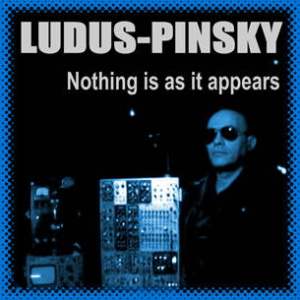
Ridiculous name. Like a villain in a cheap Victorian melodrama. Visions of Ludus (Ludicrous) twirling his moustache as the hero is fated to die horribly but then he talks too much the hero escapes and we all nod off to sleep. Meanwhile, I’m tired, so expect grumpiness.
Of the tracks Ludus says: Tracks constructed with analog rigour and a futuristic rather than rétro sound . Ludus Pinsky develops and assembles himself the equipment he works with to obtain the kind of sound he needs. The 4 tracks in this EP range from tribal electronics as in …….. to futuristic pop as in ……., from the film-score-like theme of “Nothing is as it appears” to electronic disco as in …. That’s really what it says. Which isn’t terribly helpful. The record company do try a bit harder with: “Ludus Pinsky is Lapo Lombardi’s alter ego, a multi-talented Florentine artist, well known in the Italian Reggae/Dub scene. Among others he worked with Ice MC and Il Generale. More recently he’s been sharing Alexander Robotnick’s passion for analog synths, collaborating with him on two projects, Italcimenti and The Analog Session. This is his first solo EP, featuring 4 tracks constructed with analogue rigour and a futuristic rather than retro sound.”
Umma Flute takes the acidic path from the outset, weaving a hypnotic feel like it’s Harthouse 1992. A classic acid sound, like the last 20 years never happened. But in a good way.
Nothing Is As It Appears goes for a more Moroder style synth sound, like a lost track from Midnight Express or even Blade Runner. A bit of Kraftwerk added to the mix with the vocodered stentorian vocals. A gradually escalating track which peaks briefly towards the end. Cinematic stuff.





 Abfahrt is German for “Departure”. It was and is a German record label, the creation of Torsten Fenslau.
Abfahrt is German for “Departure”. It was and is a German record label, the creation of Torsten Fenslau.